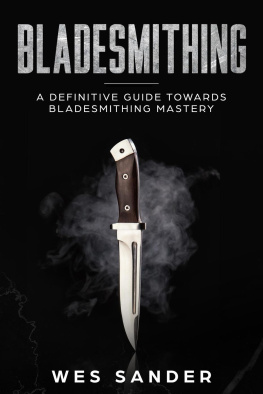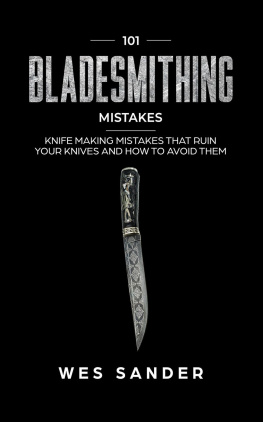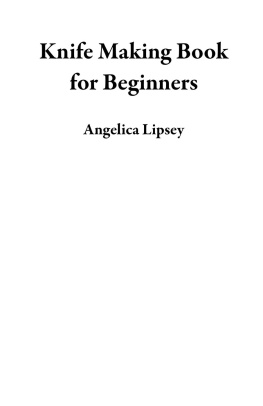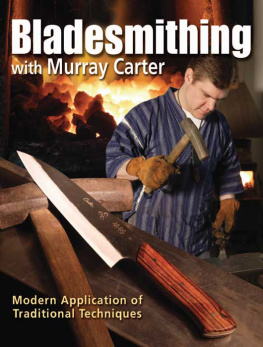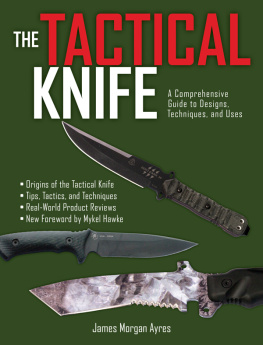BLADESMITHING
A Step-by-Step Guide to Forging Your Own Knives for Beginners
By Jake Welsh
Copyright 2020 - All rights reserved.
The content contained within this book may not be reproduced, duplicated or transmitted without direct written permission from the author or the publisher.
Under no circumstances will any blame or legal responsibility be held against the publisher, or author, for any damages, reparation, or monetary loss due to the information contained within this book. Either directly or indirectly.
Legal Notice:
This book is copyright protected. This book is only for personal use. You cannot amend, distribute, sell, use, quote or paraphrase any part, or the content within this book, without the consent of the author or publisher.
Disclaimer Notice:
Please note the information contained within this document is for educational and entertainment purposes only. All effort has been executed to present accurate, up to date, and reliable, complete information. No warranties of any kind are declared or implied. Readers acknowledge that the author is not engaging in the rendering of legal, financial, medical or professional advice. The content within this book has been derived from various sources. Please consult a licensed professional before attempting any techniques outlined in this book.
By reading this document, the reader agrees that under no circumstances is the author responsible for any losses, direct or indirect, which are incurred as a result of the use of information contained within this document, including, but not limited to, errors, omissions, or inaccuracies.
Table of Contents
Introduction
Those of you who have picked up this book because you are looking to get into bladesmithing should already have a good idea of what this practice entails. However, those who are reading this introduction and considering if this skill is something you would like to invest inthis first section is for you.
Bladesmithing is the practice through which we craft blades. Everyone who is new to the skill may immediately bring to mind images of blacksmiths hammering red hot iron and crafting medieval weapons like swords or axes. This absolutely falls into the category of bladesmithing, as these are, without a doubt, blades. However, this understanding of the practice is limited in scope.
The art of bladesmithing is about far more than swords and weapons; it is about knives and tools. When was the last time you held a sword? Chances are never. Most people have no reason to, after all. But when was the last time you held a knife? Dinner? Lunch? Breakfast? Cutting bread? Buttering that bread? How about in the workshop? Do you have blades for cutting wood or other materials?
Many of us dont realize that we are surrounded by blades all the time. Whats more, somebody had to make those. Although many are now mass produced, there is a telling lack of quality to these blades. A mass produced blade is prone to breakage, thus they need to be replaced often. This is why professional kitchen chefs will typically invest in expensive knives. They want quality, longevity, and an impressive functionality. You may think that a blade only has one function: to cut. This is mostly true, but how well it cuts and what kind of cut it makes is entirely different from blade to blade.
There is far more to bladesmithing than simply smacking hot iron against an anvil. Therefore, it is my goal with this book to introduce to you just how important and useful this skill is. It goes without saying that it can improve the quality of blades you have in your household greatly. However, even more than that, it can be used to earn money if you wish to sell your creations. On top of that, although it is a specific skill, there is a lot of crossover between bladesmithing and other forms of metalworking or even crafting in general. I am a proponent of learning at least the basics of as many crafting skills as you can because it allows you to see how you can weave together seemingly disparate skill sets to create amazing arts and crafts.
In this book, we will begin by looking at how you would get started bladesmithing. This means well need to set up a space in which to work. This is a little more complicated than something like crochet or even woodworking. Crochet is a crafting skill that you can take with you anywhere, and bladesmithing is certainly not so convenient. Woodworking is a little closer to bladesmithing, in that you require a workshop; however, bladesmithing is a more dangerous activity, and the amount of heat used in the process can be incredibly uncomfortable. This chapter will look at how you plan for and set up your workshop. It will also go over the more important safety tips that you should be aware of going forward.
Safety is an incredibly important part of bladesmithing, or really any form of crafting that uses dangerous equipment. Because it is so important, we will be seeing more about safety throughout the book. These tips arent gathered into a single chapter, but rather, they are spread out, so they can be directly noted when we are discussing the relevant topic. For example, if the book was front-loaded with all the safety advice needing consideration, then it would be much easier to forget the tips that applied to grinding when we get to the appropriate chapter. Thus, we will look at safety tips when grinding a blade in the chapter in which we discuss grinding. It is my hope that this section will help make sure these tips sink in because they are integral to enjoying this skill.
Despite setting up our workshop, we wont start using it until later in the book. Chapter two is a continuation of chapter one how it is focused primarily on the planning and designing step of the process. In chapter one, you would start to design your workshop. In chapter two, would you learn all about designing your knife. You might think that you understand blades. After all, how complicated could a piece of sharp metal be? However, if you skip out on design, then youll understand real quick that it isnt quite so simple. Consider questions, such as how long you should make the hilt or how thick the blade should be, and youll probably start to realize that you know less about blades than you thought. Dont worry; by the end of this book, youre going to know plenty.
Chapter three still doesnt quite take us to the hands-on segment of the book, but were getting close. This chapter looks at all the various tools that would be filling your workshop. The cool thing about bladesmithing is that there are actually way fewer tools needed than people may think. To be clear, there are a ton of tools that can be used in bladesmithing, but you only need a handful of tools to actually do the work. You can always purchase more tools down the road to make your experience easier or more enjoyable, but I always recommend starting with the minimum, and then purchasing more over time. This reduces the amount of money it takes to start bladesmithing, and that means you can start practicing your skills and selling blades sooner rather than later.
In chapter four, well be getting hands on, though we wont be worrying about the fire just yet. We will be starting with grinding. If youve ever watched anything with a blacksmith in it, then youve likely seen a grinding wheel before. But do you know how to use one? Dont worryyou dont need to. Thats what this book is for!
Chapter five is where we finally get into what people associate most strongly with bladesmithing: heat. This chapter will focus on the heating, shaping, and hardening of your blade. All that hard work you put into designing your blade will finally pay off in this chapter.
Now that you have a finely crafted blade, you could just stick it in a drawer if you want; but, since weve gone through all the effort of designing and making it ourselves, why not create a sheath just for your blade? In chapter six, youll do just that.



